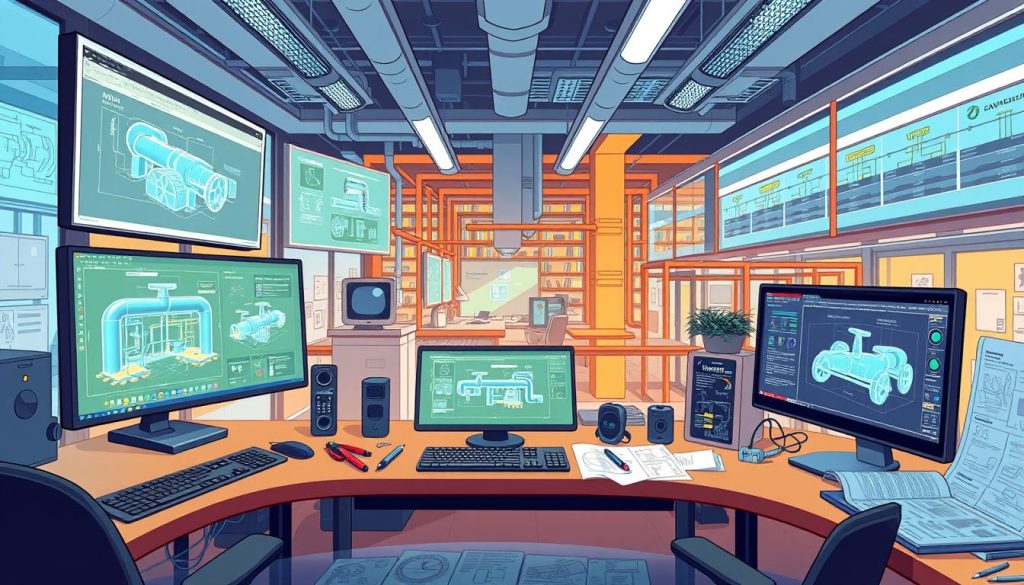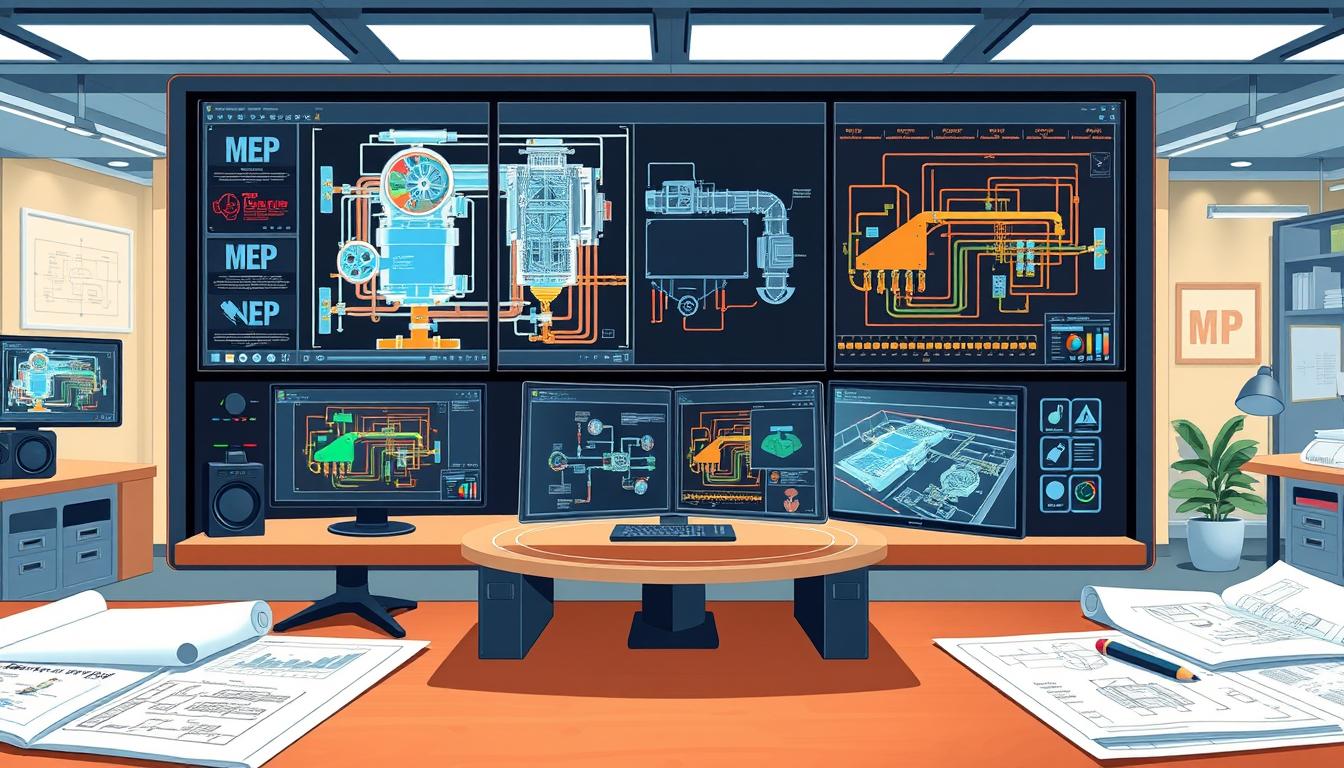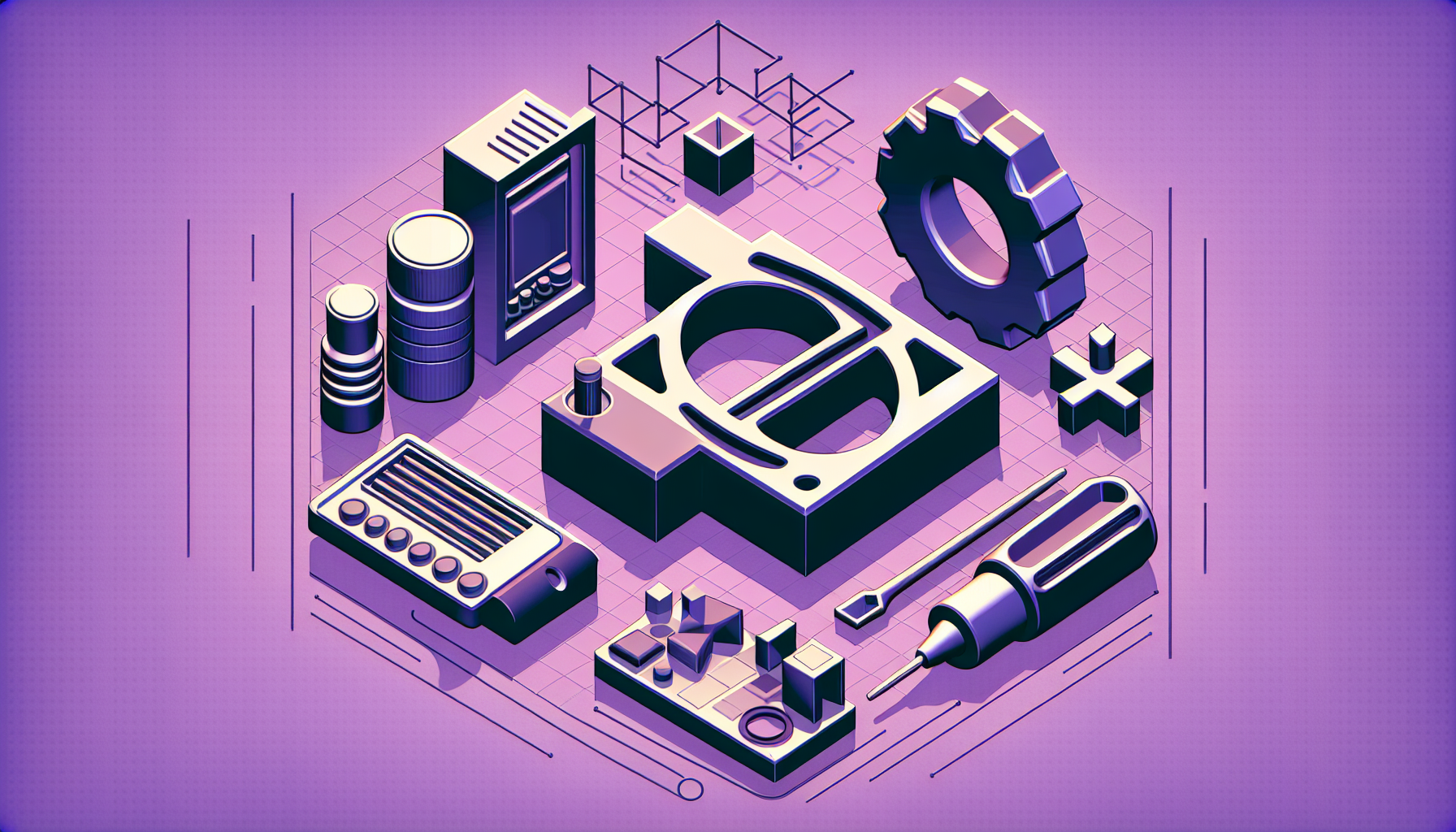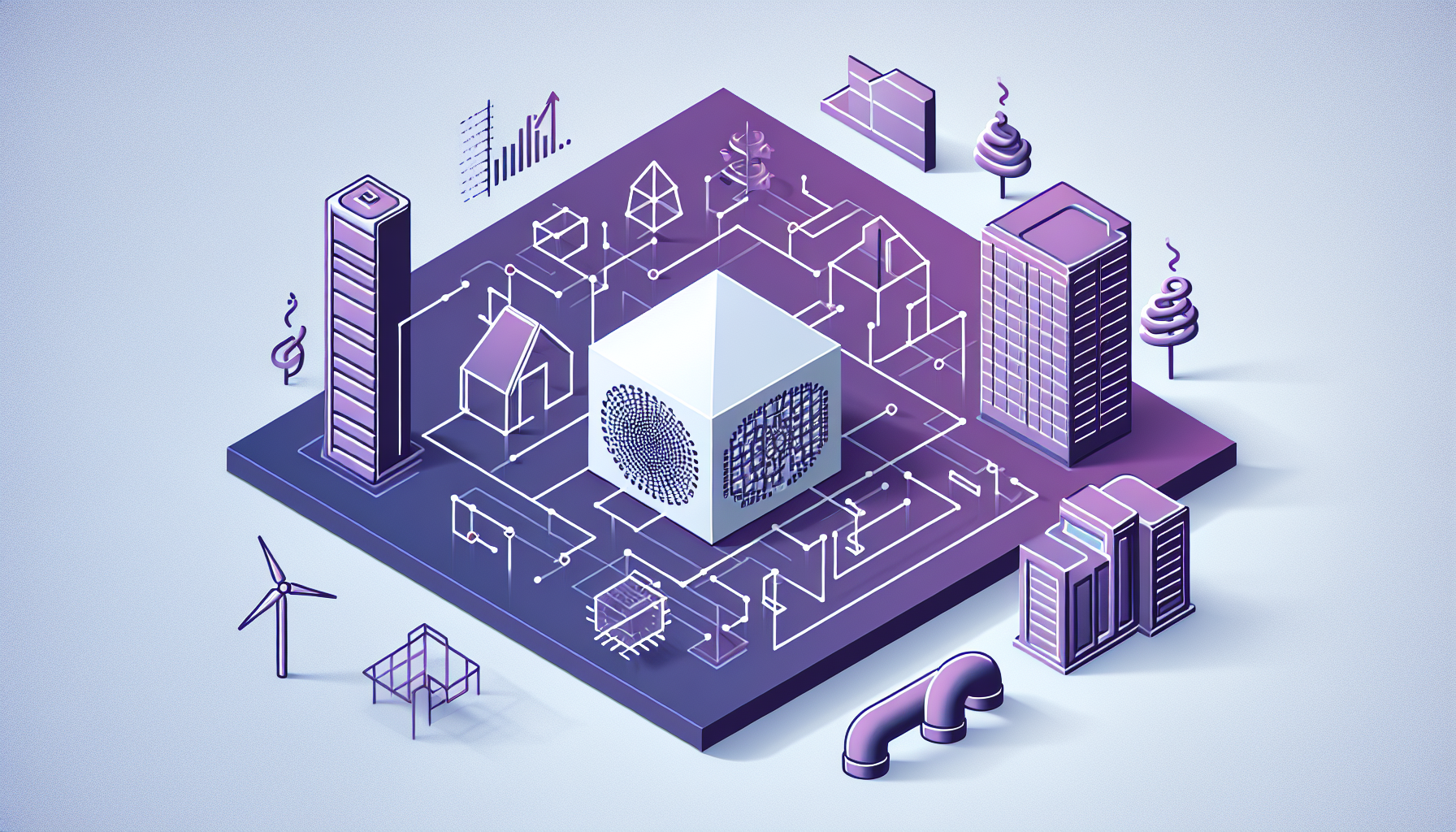If you work in construction, you’ve probably heard of MEP software. But what is it, and how does it help your projects? MEP software, short for Mechanical, Electrical, and Plumbing, is key for engineers and contractors. It helps design, model, document, and build HVAC, electrical, and plumbing systems for buildings.
Using MEP software makes it easier to create the systems that keep a building running smoothly. It ensures these systems work well together with the building’s design. Whether it’s a commercial, residential, or industrial project, MEP software helps make building services efficient and effective.
Key Takeaways
- MEP software is a critical tool for professionals in the construction industry, specializing in building services engineering.
- These software solutions streamline the design, modeling, documentation, and construction of HVAC, electrical, and plumbing systems for buildings.
- MEP software helps ensure seamless integration of essential building systems with the overall design.
- MEP software can be used in a variety of project types, including commercial, residential, and industrial.
- By using MEP software, professionals can create efficient and effective building services that meet the needs of their clients and end-users.
Introduction to MEP Software
Mechanical, Electrical, and Plumbing (MEP) software is a set of tools for designing, building, and managing building systems. It helps professionals tackle the tough challenges in the MEP field. With its many features, MEP software lets architects, engineers, and contractors make buildings more efficient, green, and affordable.
Definition and Overview of MEP Software
MEP software is a group of tools for modeling, analyzing, and coordinating building systems. It uses 3D models to show how different parts of a building work together. It also works well with CAD and BIM software, making design work better and faster.
Key Benefits of Using MEP Software
- Improved productivity and reduced errors through automation features
- Enhanced coordination and clash detection between different building systems
- Accurate energy analysis and performance simulation for more sustainable designs
- Streamlined integration with CAD and BIM software, enabling a more holistic approach to building design
- Increased data management and collaboration capabilities, fostering better decision-making throughout the construction lifecycle
Using MEP software helps professionals work better, take less risk, and build high-quality, energy-saving buildings. These buildings meet the needs of today’s construction projects.
Who Uses MEP Software?
MEP software is a key tool for many professionals. It’s not just for MEP industry professionals like engineers and designers. Its benefits reach far beyond the MEP field.
Professionals in the MEP Industry
MEP industry professionals use MEP software a lot. They need it to make their work easier and more accurate. It helps them design and install systems better.
Other Industries that Benefit from MEP Software
MEP software is also useful for others. This includes:
- Architecture firms – They use it to plan buildings better, making sure everything works well together.
- Design firms – Interior designers and others use it to add necessary systems to their designs.
- Construction companies – They use it to manage the setup of systems, making projects run smoother.
MEP software is a must-have for anyone in construction. It helps teams work together better and make decisions faster.
| Industry | Benefits of MEP Software |
|---|---|
| MEP Industry | Streamline workflows, improve project coordination, and ensure accurate design and implementation of mechanical, electrical, and plumbing systems |
| Architecture Firms | Integrate mechanical, electrical, and plumbing systems into building designs, ensuring seamless coordination and optimization |
| Design Firms | Visualize and incorporate necessary building systems into projects |
| Construction Companies | Coordinate the installation and integration of mechanical, electrical, and plumbing systems, improving project efficiency and reducing the risk of conflicts or delays |
Why is MEP Software Necessary?
MEP (mechanical, electrical, and plumbing) software is vital in the construction world. It helps ensure buildings follow current codes. It also makes sure all systems work well together without problems.
MEP software is key for meeting building codes and ensuring building systems integration. Architects, engineers, and contractors use it to create detailed plans. These plans show how mechanical, electrical, and plumbing systems work together in a building.
Streamlining Building System Design and Integration
MEP software makes designing and integrating systems easier by:
- Offering advanced modeling and visualization to spot and fix system conflicts
- Helping coordinate different trades and disciplines in construction
- Allowing for energy efficiency and system performance analysis
Using MEP software ensures buildings are safe, efficient, and meet codes. It makes buildings work well for everyone inside.
| Key Benefits of MEP Software | Description |
|---|---|
| Compliance with Building Codes | MEP software ensures building systems meet all necessary codes and regulations. |
| Improved Coordination and Collaboration | These tools help different trade professionals work together better, reducing mistakes. |
| Enhanced System Performance | MEP software lets for detailed analysis and simulation of systems. This improves energy efficiency and more. |
In short, MEP software is crucial. It helps meet building codes, ensure building systems integration. It leads to buildings that are efficient, safe, and meet the needs of those who use them.
What is MEP Software?
MEP (Mechanical, Electrical, and Plumbing) software is a powerful tool for building design and analysis. It helps professionals in the MEP industry and others. It offers many features to make building systems design easier.
Functionality and Features of MEP Software
MEP software has many features for building design and construction. These include:
- Comprehensive 3D modeling for detailed MEP system representations
- Clash detection tools to find and fix conflicts between components
- Energy analysis and performance simulation for better system efficiency
- Automated reporting and documentation for easier project management
Integration with CAD and BIM Software
MEP software works well with CAD and BIM software. This makes design and coordination easier. Changes in one software are shown in the others. This reduces errors and improves project efficiency.
| MEP Software Functionality | Integration with CAD | Integration with BIM |
|---|---|---|
| 3D Modeling | ✓ | ✓ |
| Clash Detection | ✓ | ✓ |
| Energy Analysis | ✓ | ✓ |
| Automated Reporting | ✓ | ✓ |

Top MEP Software Solutions
The construction industry has many MEP software solutions. Each offers special features to make your projects smoother. Let’s look at some top MEP software options to improve your design and engineering work.
Autodesk AutoCAD MEP Toolset
The AutoCAD MEP Toolset from Autodesk is a powerful toolset. It has advanced tools for creating, documenting, and coordinating MEP systems. This software helps you design, analyze, and visualize projects more efficiently.
Revit for MEP Engineering
Revit, from Autodesk, is a top BIM software for MEP engineers. It has a wide range of tools for modeling, analyzing, and coordinating MEP systems. This integrated approach makes collaboration and data coordination smooth in your projects.
Trimble Field Points
Trimble Field Points is a software that makes laying out BIM models in the field easier. It uses advanced positioning technologies. This ensures your field work matches the digital design, reducing costly mistakes and improving project quality.
| Software | Key Features | Primary Users |
|---|---|---|
| AutoCAD MEP Toolset |
|
MEP designers, drafters, and engineers |
| Revit for MEP Engineering |
|
MEP engineers, designers, and BIM managers |
| Trimble Field Points |
|
MEP contractors, field technicians, and surveyors |
These are some of the best MEP software solutions for construction pros. Using tools like AutoCAD MEP Toolset, Revit for MEP Engineering, and Trimble Field Points can make your workflows better. It also helps in improving collaboration and delivering high-quality MEP systems for your projects.
MEP Software for Modeling and Design
Software is key in MEP (Mechanical, Electrical, and Plumbing) design. It helps engineers and designers make accurate 3D models of building systems. MEP software has tools that make the design process smoother. It also helps with better visualization, coordination, and analysis during construction.
Powerful Modeling Tools and Capabilities
MEP software for design has advanced modeling tools. These tools create detailed digital models of HVAC, electrical, and plumbing systems. They make sure each system works well together in the building design.
Some important features of MEP software include:
- Intuitive 3D modeling interfaces for creating precise, parametric models of MEP components and systems
- Intelligent object libraries and databases that simplify the selection and placement of MEP equipment and fixtures
- Advanced routing and coordination tools to accurately route ductwork, piping, and electrical conduits
- Automated clash detection and conflict resolution features to identify and resolve design conflicts
- Seamless integration with BIM (Building Information Modeling) platforms for comprehensive design and analysis
Using these MEP software for modeling tools, design teams can integrate MEP systems well. This leads to better project outcomes and fewer construction problems.

MEP Software for Collaboration and Coordination
Collaboration and coordination are key in the construction world. MEP software is a big help here. It has strong clash detection tools. These tools spot problems between building parts early on.
This makes fixing issues easier and keeps the project running smoothly. It’s all about teamwork and making decisions together.
Clash Detection and Conflict Resolution
MEP software’s clash detection is a game-changer. It checks digital models of systems like electrical and plumbing. This way, it finds problems before they cause big headaches.
It also helps teams work together to solve problems. This ensures all parts of the building work well together.
| Feature | Benefit |
|---|---|
| Clash Detection | Identify potential conflicts between building systems early in the design process |
| Collaborative Platform | Facilitate communication and decision-making among stakeholders |
| Real-time Data Sharing | Enable seamless coordination and reduce the risk of costly rework and delays |
Using MEP software for teamwork makes construction better. It makes projects run smoother and buildings better. It’s all about teamwork and quality.
MEP Software for Analysis and Simulation
Robust MEP software solutions do more than design and coordinate. They offer advanced tools for analysis and simulation. These tools are key for ensuring buildings are energy efficient and perform well. They let engineers test their designs, improve performance, and meet green goals before construction starts.
Energy Analysis and Performance Simulation
Simulating a building’s energy use and system performance is a big deal for MEP pros. MEP software for analysis creates detailed energy models. These models consider climate, building orientation, materials, and equipment. This helps engineers make choices that save energy and reduce environmental harm.
MEP software for simulation lets pros test HVAC, plumbing, and electrical systems virtually. By mimicking real-world conditions, they can spot problems, tweak designs, and ensure systems work as planned after construction.
- Analyze a design’s energy efficiency and environmental impact
- Simulate the behavior of HVAC, plumbing, and electrical systems
- Identify and resolve potential performance issues before construction
- Ensure designs meet or exceed sustainability and energy-saving requirements
Modern MEP software is vital for creating buildings that are efficient and meet today’s needs. Its advanced analysis and simulation tools help make buildings better for the environment and the industry.
Challenges in MEP Software
The construction world is always changing, and MEP (Mechanical, Electrical, and Plumbing) software faces new challenges. Professionals must understand engineering basics and keep up with industry changes.
Mastering Engineering Principles
Using MEP software well means knowing the engineering behind it. If users don’t get this, they might face legal problems. This is because the software’s results might not match real-world building systems.
To avoid these issues, MEP experts need to learn the software’s technical base. This includes physics, thermodynamics, and other key engineering areas.
Adapting to Evolving Challenges
Building systems and construction methods keep getting better, and MEP software must too. Users need to keep learning about new software features and industry trends. If they don’t, they might fall behind and miss chances.
To tackle these problems, MEP pros should always be learning. They should look for training, go to industry events, and stay current with new tech and trends. By doing this, they can use MEP software to its fullest and create better, more affordable buildings.
Impact of Technology and AI on MEP Software
Technology has changed MEP software a lot. Cloud-based tools, BIM workflows, and AI are making design and construction faster. AI can do simulations quickly, giving engineers fast insights and speeding up design.
Role of Artificial Intelligence in MEP Design
AI in MEP software is still growing but it could change the industry a lot. It could make engineers and designers focus more on creative tasks. AI can look at lots of data, find patterns, and suggest ways to make buildings better.
This could save a lot of time and money. It could also make buildings work better.
But AI isn’t the only thing changing MEP software. Cloud tools and BIM workflows are also making a big difference. They help teams work together better, share data in real time, and make decisions faster.
These changes are making work more efficient and communication better. They help make design choices more informed.
As AI in MEP design grows, it’s important for professionals to keep up. They need to learn how to use AI and simulations well. By doing this, they can make buildings more innovative, sustainable, and cost-effective.
Conclusion
MEP software is now key for engineers, designers, and contractors in building. It makes designing and building HVAC, electrical, and plumbing systems easier. This ensures these systems work well with the building’s design.
The future of MEP software is exciting. It will keep improving with new tech like cloud-based tools and AI. This will make building services engineering more efficient and sustainable.
The key takeaways from this article are clear. MEP software is vital in construction, offering many benefits. It’s also important to keep up with new tech to improve our work.
As the future of MEP software grows, we’ll see even better tools. These will help shape the buildings of tomorrow.





0 Comments